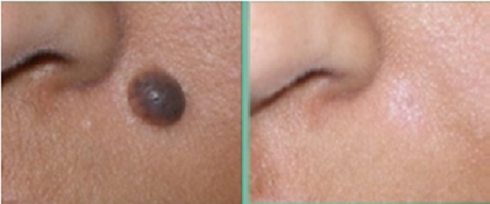These terms refer to common, non-cancerous or benign skin lesions and amongst others also include seborrheic keratosis, skin tags, freckles, moles, and benign lentigines. Best Life Clinic ensures a removal of these with the progressive radiofrequency technology.
Skin growth of brown or black colour signifies moles, which are found to appear in groups or alone, anywhere on the skin. This appearance, the majority of times, is seen in early childhood, or within 25 years of life. Typically any adult would normally have 10-40 moles on their body. Usually, the moles change over time, some may though do not change while some may completely disappear gradually. The changes include, change in colour, development of hair in the mole and/or becoming raised.

A small tissue flap, which with a connecting stalk, hangs off the skin, is called a skin tag. Not dangerous by nature, these are commonly seen in chest, neck, armpits, back, groin area or under the breasts. Most commonly, they appear with weight gain in women and also in elderly people. These painless skin growths can get irritated with something that rubs against them like, jewelry or clothing.

Small brown spots on the skin of the arms, face, chest, neck are identified as freckles, which are not dangerous and extremely common. Usually they appear on lighter skins and/or red haired individuals most often in summers.

A piece of skin with quick growth as hard, bumpy and rough skin is referred to as warts and is caused by human papilloma virus infection. Warts pose no health risk, but cam spread with direct contact, making them contagious. They may appear on any body part like genitals, fingers, palms and feet bottom. They may be typically flesh or brown coloured while genital warts may be of red or pink colour.
With the exposure to sun, skin may develop flat black-brown spots, anywhere on the body and these are termed as age spots.
The radiofrequency is used at Better Life Clinic for diverse cosmetic procedures and more extensively, the RF ablative technique is used in removal of benign naevi or more commonly called moles. The naevus cells or the pigment cells are present in the dermo-epidermal junction of the skin superficially and are responsible for a gradual development of moles on our body. With the progress of times, the pigment cells clump and travel to the dermis layer, resulting in a raised skin tissue of the intradermal naevus. This radiofrequency treatment primarily targets such moles.
For conducting this medical grade cosmetic procedure, local anaesthetic is used to numb the mole and then the mole is shaped and flattened using a radiofrequency instrument. There is no bleeding during the process as the blood vessels are sealed. The procedure shows slight redness that disappears with time and though there are immediate visible results, the final result take 2-3 months to shape. Good clinical expertise ensures that over-correction is avoided and unnecessary tissue removal is prevented. This may require a touch up after few weeks.
Most commonly, this technology is used in skin lesions removal. The various kinds of skin lesions include, Melanocytic naevi (moles), Warts, skin tags, Seborrhoeic kerratosis (age or wisdom spots), and Syringoma (harmless tumours within sweat glands).
In addition, radiofrequency also provides cosmetic solution for removal of facial telangiectasia (thread veins), resurfacing of scars (chicken pox, acne etc), resurfacing of lips to treat perioral lines, resurfacing in case of Rhinophyma (bulbous appearance of nose due to rosacea in men), upper and lower Blepharoplasty (treatment of sagging upper eyelid and lower eyelid eyebag) and skin tightening with Pellev.
Various clinical studies have compared radiofrequency surgery to laser incision and considered it much superior to scalpel incisions. With minimal thermal damage, comparatively to scalpel excision, and electrode cautery, this technology ensure minimum scarring.
Thus, the various advantages of Radiofrequency primarily include, quick healing, zero or minimal bleeding, minimal or aesthetically pleasing scarring, reduced operating time and can be conducted as an OPD procedure in office or clinical settings.